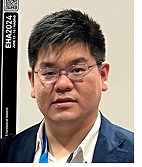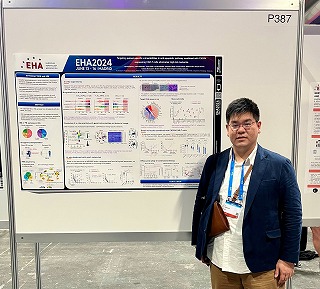29th EHA Congress Travel Award 受賞レポート 中川 諒

名前:中川 諒【東北大学病院 血液内科】
発表形式:Poster
Title:
Targeting patient-specific vulnerabilities in anti-apoptotic pathway combined with CXCR4 expressing CAR-T cells eliminates high-risk leukemia
Authors:
Ryo Nakagawa 1, 4, Mari Hashimoto 1, Yoriko Saito 1, Ari Itoh-Nakadai 1, Shinsuke Takagi 2, Hanae Amitani 3, Mikiko Endo 3, Naoyuki Uchida 2, Yukihide Momozawa 3, Shuichi Taniguchi 2, Hideo Harigae 4, and Fumihiko Ishikawa 1
Affiliations:
1. Laboratory for Human Disease Models, RIKEN Center for Integrative Medical Sciences, Yokohama, Kanagawa, Japan
2. Department of Hematology, Toranomon Hospital, Tokyo, Japan
3. Laboratory for Genotyping Development, RIKEN Center for Integrative Medical Sciences, Yokohama, Kanagawa, Japan
4. Department of Hematology, Tohoku University, Sendai, Miyagi, Japan
Abstract:
Background: Despite recent advances in molecular specific targeting drugs, prognosis is dismal for relapsed and refractory leukemia with multiple mutations and chromosomal aberrations.
Aims: In this study, we aimed to identify patient-specific therapeutic vulnerabilities in high-risk lymphocytic and myeloid leukemia.
Methods: We designed translational research connecting multi-omics analyses, in vitro screening and in vivo treatment using patient-derived xenograft (PDX) models to create therapeutic interventions for high-risk ALL, MPAL and CML.
Results: First, we identified leukemia-initiating cell fractions and phenotypical characteristics in each leukemia patient specimen with xenogeneic transplantation for acute lymphocytic leukemia (ALL), mixed phenotype acute leukemia (MPAL) and chronic myeloid leukemia (CML). Through the global transcriptome analysis and in vitro drug screening, we found anti-apoptosis molecules (BCL-2, MCL-1 and IAP) and molecules related to cell division (AURKB) were critical for leukemic cell survival in genetically-diverse leukemia including 28 B-ALL/MPAL, 9 T-ALL/MPAL and 12 CML cases. There was leukemia lineage-specific responsiveness to targeted inhibition. We found high responsiveness of T-ALL/MPAL to venetoclax (88.9%, eight out of nine samples) and high sensitivity to IAP inhibitor (AZD5582) in CML(83.3%, 10 out of 12 samples). B-ALL/MPAL showed overlapping responsiveness to BCL-2 and IAP inhibition. As opposed to our recent findings in acute myeloid leukemia (AML)(Hashimoto, Saito, et al., Nature Cancer 2021), there was no significant correlation between somatic mutations or chromosome aberrations and in vitro sensitivity in diverse non-AML leukemia. We utilized single-cell RNA sequencing to investigate lineage-dependent therapeutic vulnerabilities in leukemic cells.
As informed by in vitro sensitivity, we performed in vivo treatment with AZD5582 and/or venetoclax-based combination treatment using PDX (patient-derived xenograft) models. We observed complete elimination of leukemic cells in 8 of 11 B-ALL/MPAL, 3 of 4 T-ALL/MPAL and 2 of 4 CML. Combination therapy eliminated Ph+ (Philadelphia chromosome positive) leukemic cells even in the clinically aggressive cases with T315I mutation. However, six cases failed to achieve profound remission. we examined potential relation between mutational profile and in vivo elimination by target DNA sequencing. We found each of the resistant cases carried mutations in either KRAS and/or TP53, which was consistent with clinical aggressiveness of KRAS/TP53-mutated leukemia.
To further identify in vivo resistant mechanism, we examined the expression profile of 31 proteins, including apoptotic molecules, transcription factors, immune modulators and cell surface markers by mass cytometry. Protein expression profiling revealed in vivo resistant cases exhibited higher expression of CXCL12, a ligand for chemokine receptor CXCR4, compared with sensitive cases.
To overcome highly resistant cases with mutations in KRAS and/or TP53, we created CXCR4-expressing CAR-T cells targeting CD19 for B-ALL and CD7 for T-ALL and CML. Pre-treatment with small molecules could reduce leukemic cell burden and subsequent treatment with CXCR4-expressing CAR-T cells completely eradicated leukemic cells of peripheral blood, bone marrow, spleen and liver. Moreover, combination of small molecules and CXCR4-expressing CAR-T cells eliminated resistant leukemic cells without severe cytokine release syndrome, which is triggered by elevation in several cytokine such as human IL-2, IL-10 and GM-CSF.
Summary/Conclusion: Altogether, our precision medicine strategy targeting patient-specific anti-apoptotic proteins and cell surface antigens may improve clinical outcome in poor prognosis ALL, MPAL and CML.
EHA2024参加レポート
この度はJSH Travel Award for EHA Congressにご採択いただき,感謝申し上げます。今年のEHAはスペインのマドリードで開催されました。会場であるIFEMAには世界中から多くの血液内科医・研究者が参加し,活気に溢れておりました。学会期間中は天気にも恵まれ,気温は30度近くありましたが,湿度が低く,過ごしやすい天候でした。
私は開催日2日目のポスターセッションで,高リスク白血病に対する新規治療標的の同定および,分子標的薬とCAR-T細胞療法の有効性に関する基礎研究の報告をさせていただきました。予後不良のALL, MPAL, CMLの患者検体を用いて,transcriptome analysis, in vitro screeningを通してアポトーシス経路における治療標的を見出し,抗アポトーシス分子阻害剤の有効性についてPDXモデルを使用したin vivoで確認しました。また,分子標的薬治療では根治が難しい高リスク遺伝子変異を有する白血病に対してはサイトカインを発現させたCAR-T細胞を併用することで白血病細胞を根絶させることができました。参加者の方からはCAR-T細胞の作製やin vivoの治療方法についての質問をいただき,議論いたしました。
世界中から興味深い発表が数多くある中で,予後不良白血病に対する代謝経路における新規治療分子の検索やそれらの標的とした治療法の評価に関する基礎研究報告を拝聴することができ,今後の研究と臨床に生かしていきたいと感じました。
また,ほかのTravel Grants受賞者の方との交流会もあり,近しい学年,境遇の先生と,臨床や研究・プライベートのこと等を話すことができ,今後の励みとなりました。
EHA参加にあたり,サポートいただきました日本血液学会国際委員会の先生方,事務局の皆様に厚くお礼申し上げます。最後に,このような素晴らしい機会を与えてくださった張替秀郎先生,石川文彦先生,研究にご協力いただいている理研ヒト疾患モデル研究チーム,基盤技術開発研究チーム,虎の門病院の皆様に心より感謝申し上げます。
